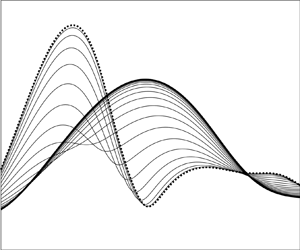Article contents
Effects of spanwise-periodic surface heating on supersonic boundary-layer instability
Published online by Cambridge University Press: 08 April 2022
Abstract

The effects of streamwise-elongated, spanwise-periodic surface heating on a supersonic boundary-layer instability are investigated under the assumption of high Reynolds number. Our focus is on the lower-branch viscous instability and so the spanwise spacing of the elements is chosen to be of  $O({\textit {Re}}^{-3/8}L)$, the wavelength of the latter, where
$O({\textit {Re}}^{-3/8}L)$, the wavelength of the latter, where  ${\textit {Re}}$ is the Reynolds number based on
${\textit {Re}}$ is the Reynolds number based on  $L$, the distance from the leading edge to the centre of the elements. The streamwise length is assumed to be much longer in order to simplify the mathematical description. Starting with classical triple-deck theory, the equations governing the heating-induced streaky flow are derived by appropriate rescaling. When Chapman's viscosity law is adopted, a similarity solution is found. The stability of the streaky flow, which is of a bi-global nature, is shown to be governed by a novel triple-deck structure characterised by fully compressible dynamics in the lower deck. Through asymptotic analysis, the bi-global stability is reduced to a one-dimensional eigenvalue problem, which involves only the spanwise-dependent wall temperature and wall shear. The instability modes may be viewed as a continuation of oncoming first Mack modes, but might also be considered as a new kind since they exhibit two distinctive features: strong temperature perturbation near the wall and spontaneous radiation of an acoustic wave to the far field, neither of which is shared by first Mack modes. Numerical calculations, performed for two simple patterns of spanwise-periodic heating elements, demonstrate their stabilising/destabiling effects on modes with different frequencies and spanwise wavelengths.
$L$, the distance from the leading edge to the centre of the elements. The streamwise length is assumed to be much longer in order to simplify the mathematical description. Starting with classical triple-deck theory, the equations governing the heating-induced streaky flow are derived by appropriate rescaling. When Chapman's viscosity law is adopted, a similarity solution is found. The stability of the streaky flow, which is of a bi-global nature, is shown to be governed by a novel triple-deck structure characterised by fully compressible dynamics in the lower deck. Through asymptotic analysis, the bi-global stability is reduced to a one-dimensional eigenvalue problem, which involves only the spanwise-dependent wall temperature and wall shear. The instability modes may be viewed as a continuation of oncoming first Mack modes, but might also be considered as a new kind since they exhibit two distinctive features: strong temperature perturbation near the wall and spontaneous radiation of an acoustic wave to the far field, neither of which is shared by first Mack modes. Numerical calculations, performed for two simple patterns of spanwise-periodic heating elements, demonstrate their stabilising/destabiling effects on modes with different frequencies and spanwise wavelengths.
- Type
- JFM Papers
- Information
- Copyright
- © The Author(s), 2022. Published by Cambridge University Press
References
REFERENCES
- 5
- Cited by



